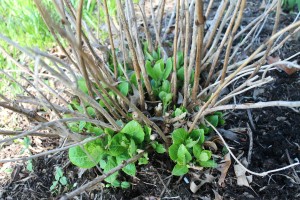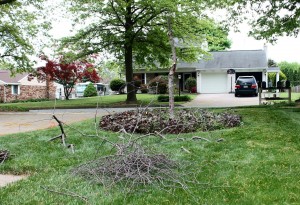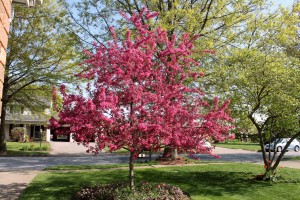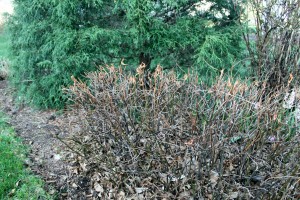The Verdict of Another Rough Winter
May 19th, 2015
I was expecting the cherry laurels and nandinas to brown out from the cold winter wind.
I was expecting the crape myrtles to die back to the ground and the hydrangea flower buds to take another beating.
What I wasn’t expecting was for my 20-year-old ‘Prairifire’ crabapple to die in the front yard.
Crabapples are reliably hardy here, even in colder-than-usual winters. And this one was fully acclimated to the site and doing well enough that its blooming glory made the cut as the cover shot on my “Pennsylvania Getting Started Garden Guide.”
Now all I have is a skeleton of dead sticks, the book photo, and the memories of Mays past.
I’m far from alone in mopping up after another damaging winter.
From the reports I’m getting and the yards I’ve been seeing, our woody plants took varying degrees of hits.
By and large, perennials and groundcovers came through winter without incident, likely because of the insulating effect of the nearly winter-long snow cover.
But trees, shrubs and upright evergreens had no such protection, so the less winter-tough ones took the brunt of those many zero-degree nights and branch-numbing winds.
As you might guess, the borderline-hardy stuff generally took the worst beating.
All of my crape myrtles, for example, have nothing but brittle wood above ground. On the plus side, some are pushing new growth from the base, which means they’re alive but basically starting over.
Ditto for my hardy camellias, which weathered winters nicely for 15 years with only some minor leaf browning and windburned flower tips in some years. Then the winter before last killed everything except the trunks, and this past winter killed off last season’s twiggy growth that valiantly tried to resurrect the southern belles. I’m seeing just a few new green buds so far.
Broadleaf evergreens such as cherry laurel, nandina, leucothoe, boxwood, euonymus, sweetbox and even some hollies and azaleas came out of winter looking more like “everbrowns” in some yards. Ones out in the open fared worse than ones protected by house walls and courtyards.
While the broadleafs still might look pretty bad, most will recover. So long as just the leaves browned from the cold wind and the branches remain alive, the plants will slough off the brown foliage as new leaf buds push out and open.
I’m more surprised and less optimistic about some of the still-bare branches on species that usually don’t suffer much winter damage.
Two in particular are Japanese maples and cherries.
I’m hearing about and seeing random dead branching on those two species, both of which should have leafed out fully by now.
That’s a bad sign, especially if you try to bend the bare branches and find that they’re brittle and snapping off and showing no sign of green just inside the bark.
I’m also seeing a lot of dead branch tips on bigleaf hydrangeas, which could spell another June with diminished or no flowers since the bulk of flower buds form toward the ends of these branches.
And I’m seeing more branch dieback than usual on butterfly bushes, Virginia sweetspires, St. Johnsworts, Leyland cypresses and shrub roses.
If this wood is dead, all you can do is cut it off and hope there’s enough life left in the plant that it’ll fill in and eventually recover into some semblance of a nicely formed specimen again.
Up until last spring, I would’ve said that everything that’s coming back to life would be back to life by the end of May. But since some apparently-dead plants were still leafing out for the first time as late as the end of June last year, I’d now say give your apparent-deads until then before getting out the shovel.
Once you’re sure branch tips or whole branches are dead, prune them off – back to live growth. This may involve cutting whole branches back to the trunk, or in the case of crape myrtles, pruning back everything to where new shoots are emerging from the base.
After getting rid of dead wood, it’s OK to prune surviving wood to make the plant look reasonably shaped again. Try to limit that as much as possible since these winter-whacked plants can use as many sun-grabbing leaves as possible to generate energy to regrow lost limbs.

Once you’re sure branches or branch tips are dead, prune them off. Here, only new basal growth is emerging from these hydrangeas.
If everything above ground is dead and there’s no sign of shoots emerging from the base by the end of June, think about what you’d like to replant in honor of the botanically deceased.
I should mention that not all of the current plant mayhem is due to winter cold.
I got a question last week from a reader wondering why his junipers are almost dead, even though he wrapped them with burlap over winter. Junipers are generally very winter-hardy and don’t even need burlap in winter.
I think the answer is that the dead branches are due to voles eating the roots out underneath. Voles not only apparently enjoy the taste of juniper roots and bark (at least when there’s not much else available to eat), but they like the protection from hawks offered by evergreen juniper foliage overhead.
I’ve had voles kill entire juniper bushes in my yard from eating roots in winter as well as stripping the base of the trunks. They’ve also killed an apple tree and a rose bush in my yard from winter root-feeding.
And if you think deer damage in the landscape was worse than usual this winter, you’re not imagining it.
Several of my Garden House-Calls clients have pointed out assorted worse-than-usual damage, including eaten plants near the front door and in beds that deer never bothered before.
The likely explanation is that deer had less to pick from due to the snow cover, so those landscape hollies, arborvitae, yews and azaleas looked even tastier than usual.
At least warm weather is finally here and enough IS blooming and looking good to help us forget about January. We should be good now for at least 5 more months.
Then, what are the odds that we’ll have three plant-punishing winters in a row?










